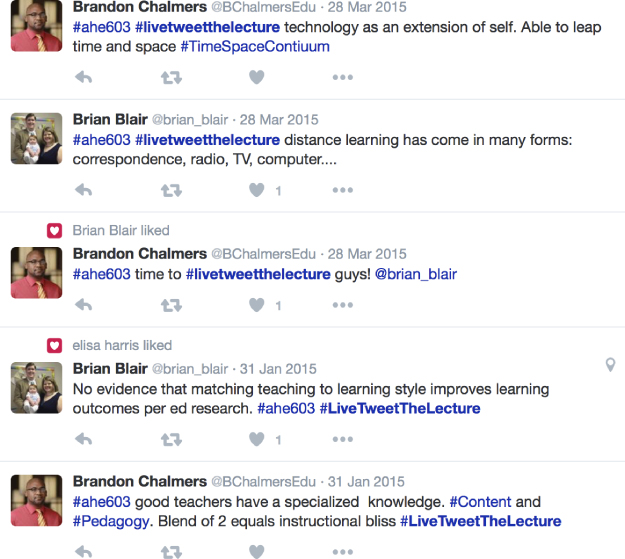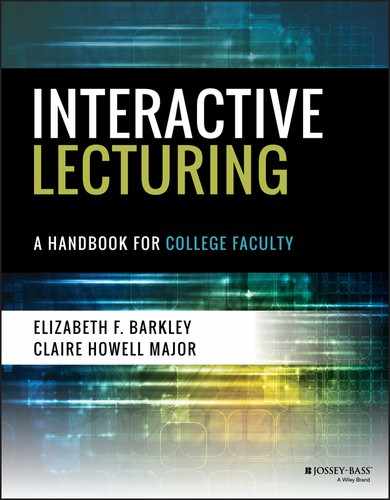ACTIVE LEARNING TECHNIQUE 12
Live-Tweet Lecture
| Complexity involved in | |
| Planning | LOW |
| Developing Materials | LOW |
| Implementing in Class | LOW |
Description and Purpose
In a Live-Tweet Lecture, the professor asks students to use Twitter, a microblogging platform that restricts posts to 140 characters, to share important ideas about the content of a lecture while it is in progress. The Live-Tweet Lecture enables professors to use social media to foster student engagement. It provides students with a specific task to complete during the lecture that requires them to actively engage with the content. The posts also enable back-channel discussion that can add insight and value to the lecture itself.
In addition to posting, students can also mark some tweets as “favorites” and return to them later, or alternately, they can retweet posts in order to extend the discussion to their followers. The technique can provide students with a collaborative set of class notes from the lecture. Live-Tweet Lecture makes intentional use of student cell phones, which means students have fewer opportunities to use them for personal purposes during class; this approach can help students view the phone as a tool that can assist their learning. Moreover, Live-Tweet Lectures also provide useful data by which instructors can gauge student understanding.
Preparation
- If you have not already done so, set up an account on Twitter (twitter.com).
- Ask students to sign up for Twitter. You may want to require sign-up for all students, or you may want to make it optional for those who wish to participate. You may also want to ask students to send their Twitter handles to you so that you can determine which of your students have tweeted.
- Decide what you will ask students to live-tweet. You may ask them to simply summarize the key points from the lecture. You might ask them to post their personal experiences related to a given topic. You might ask them to post questions as they occur to them.
- Create a hashtag, which is a word or phrase that is preceded by a hash (#) and used to identify messages focused on a specific topic (e.g. #AHE603LTL). The hashtag enables students to connect with each other and search for other students' posts, which in turn allows for a public, real-time conversation about the lecture among students.
Procedures
- Announce the activity and invite students present at the lecture to actively tweet during the lecture itself. If you have a specific tweeting task for students (e.g., post questions you have about the content), be sure to announce it as well.
- Begin the lecture.
- At the end of the lecture, hold a discussion on the questions and ideas raised on the Twitter back channel.
| Video Lecture | Large Lecture |
| If your online course has synchronous sessions during which you lecture, approach Live-Tweet Lecture in the same way you would in an on-site class. In an asynchronous course, “live” in the Live-Tweet Lecture happens differently than in an on-site course. Although students may still tweet “live” as they watch the lecture individually, the back-channel conversation that Twitter provides will be asynchronous. That is, students will watch the lectures at different times, so their tweets will show up in different places in the Twitter feed. However, the hashtag will enable students to search for each other's posts, and thus this technique still has the benefits of recording in-the-moment thoughts and of creating a collaborative set of class notes. | This approach to active listening works well for large and small classes alike. If you are concerned about students tweeting too much information, appoint selected students to summarize the hashtag after each session. Consider offering extra credit for student volunteers. You can also archive each week's tweets. Moreover, some LMSs allow for embedding tweets into the course management page. |
Examples
College Teaching (Lecture)
In this graduate-level education course focused on teaching in colleges and universities, the professor required out-of-class engagement through Twitter as a part of course participation. Most students “followed” the instructor on Twitter as well as their classmates. She also decided to encourage students to live-tweet the lectures.
Prior to one class session, students read articles about technology in higher education. In class, the professor announced that she had a lecture on the topic of online learning as a form of instructional change. She told students that they could live-tweet the lecture and invited them to do so. As she proceeded to lecture, some students tweeted more than others, but many of the other students favorited and retweeted the students who tweeted. A portion of the exchange can be found in Figure 17.12.

Figure 17.12 Sample Tweet
Source: Reprinted with permission of the participants.
The students reported that live-tweeting helped them stay focused on the lecture content, whether they were summarizing, favoriting, or retweeting. The professor noted that the tweeting activity was good for student attention, and she believed that students captured important points in their exchanges.
The History of the American University (Large Lecture)
In this course, the professor decided to use Live-Tweet Lecture and provided students with a hashtag before the lecture each week. Students in one section generated more than two thousand tweets (more than one hundred tweets per lecture), and more than half the class tweeted at some point or another.
The professor was pleased with the technique. He felt it encouraged active engagement in lectures and prompted students to use their phones to good end during class. The professor also found that it created a repository of supplemental course material, disseminated content widely, and helped students who missed class catch up quickly. Moreover, the professor felt that it provided him with instant feedback on the lecture; he could quickly see what points had resonated with students and which had been unclear or boring—information he did not feel he would have received from students otherwise.
Communication Technology, Culture, and Society (Video Lecture)
In this communications course, students examine the ways that culture, technology, and society have influenced each other over time. They read various articles and apply the ideas from the readings to critical analyses of particular cases. The students who take the course are generally majoring in communication and information science. The professor created fifteen- to twenty-minute video lectures on various topics such as the telegraph, the advent of the Internet, the development of the information society, digital culture, and so forth. The professor felt that the students were not attending to the video lectures, so he decided to use Live-Tweet Lectures.
As students watched the lectures, they had to submit at least one tweet per fifteen-minute mini-lecture. The tweet could be an observation, a reflection, a question, or anything else that students deemed on topic. Students submitted tweets from their own course-specific Twitter accounts set up for the purpose of engaging in the activity, which also preserved student privacy and did not interfere with a student's personal tweeting. To collect student tweets, the professor created a separate Twitter account to compile tweets in one public feed using GroupTweet, which is an application that enables retweeting all tweets sent to a class account and making them visible to all students in a class.
Variations and Extensions
- Make the tweeting anonymous by using a computer lab for class. Prior to the students' arrival to class, log each computer into a Twitter account.
- Use tweeting as a pre-lecture activity. Ask students to tweet questions prior to each lecture related to the specific topic. Make sure your lecture addresses them, and ask students to post answers while you lecture.
- Ask students to create an aggregate of the tweets from the class as a final project. They could use a service such as Storify, which can combine posts to a hashtag into a single, chronological narrative and also allows the addition of comments. Alternately ask students to simply copy tweets into a word processing document.
Observations and Advice
Students may be nervous initially about having classwork viewed in the open, but they will likely overcome initial reticence and enjoy the activity after they have participated in this technique a few times. If you require students to sign up for Twitter, however, allow or suggest use of pseudonyms so that they do not need to provide personal information on the open web.
Be sure that you don't post any responses that could be construed as grading so that you do not violate students' rights to privacy. You may want to provide students with specific guidance about using Twitter. See the following information adapted from New York University (n.d.).
Key References and Resources
- Aebel, I., & Lund, B. (2013). Teaching with Twitter. Retrieved from www.tamuk.edu/cehp/hkn/docs/Twitter.pdf
- Birnholtz, J., Hancock, J., & Retelny, D. (2013). Tweeting for class: Co-construction as a means for engaging students in lectures. Retrieved from http://socialmedia.northwestern.edu/files/2012/09/twitternote_revision_CHI13_130123_camready_a2.pdf
- Evans, C. (2013). Twitter for teaching: Can social media be used to enhance the process of learning? British Journal of Educational Technology, 45, 902–915.
- New York University. (n.d.). Twitter explained. Retrieved from www.nyu.edu/content/dam/nyu/studentAffairs/images/Explained/twitter/pdf
- Parry, D. (2008, January 23). Twitter for academia [Blog post]. Retrieved from http://academhack.outsidethetext.com/home/2008/twitter-for-academia/
- Pate, A. G. (2015). Tweeting during lectures/tutorials: Engaging learners-not clipping their wings. Retrieved from www.gla.ac.uk/media/media_309215_en.pdf
